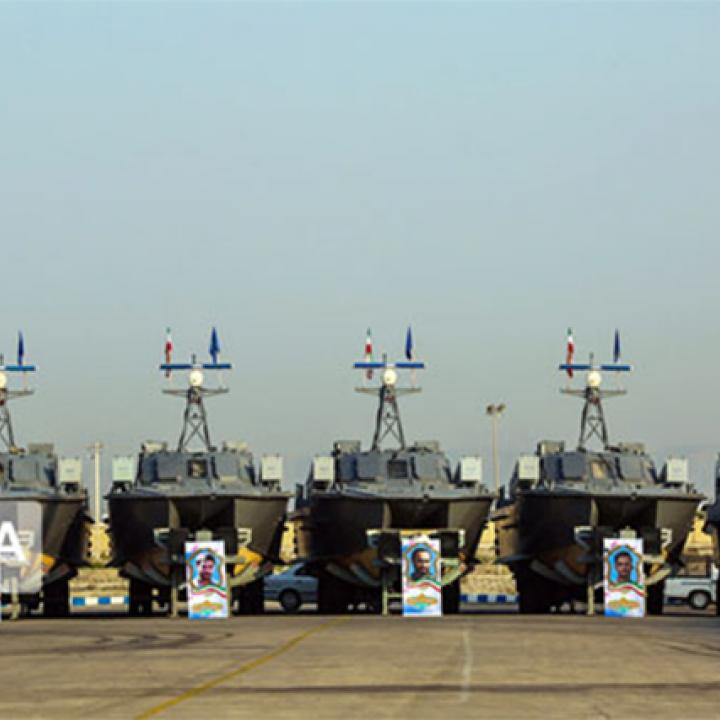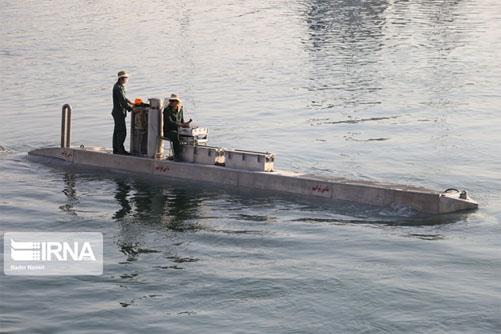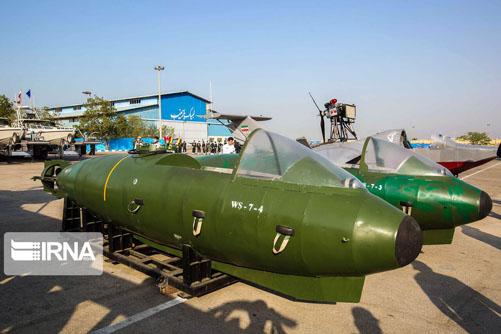

The regime may eventually use larger vessels to project power beyond the Gulf, but even its more modest recent additions portend further confrontations and weapons proliferation in local waters.
On May 28, Iran’s Islamic Revolutionary Guard Corps Navy (IRGCN) reportedly took delivery of more than 100 patrol and missile attack craft in a publicized ceremony attended by Defense Minister Amir Hatami, whose Maritime Industries Organization was responsible for the design and production of most of the boats. The unveiling ceremony was designed to send a message to the United States following a series of tense encounters, as well as a May 20 notice from the U.S. Navy that all local vessels must remain at least 100 meters away from its ships.
Indeed, Tehran took the notice as an insult, with General Hatami threatening to tighten the Iranian “security belt” around the Persian Gulf and the Strait of Hormuz as a direct counter to the “increased efforts by the superpowers to expand their direct [military] presence in the region.” He also condemned the “anti-Iranian military coalition, which is formed to threaten the security of the Strait of Hormuz and counter Iran’s control over this international waterway.” Despite his bluster and claims of control, this represents one of the few times an Iranian official has used the term “international waterway” (though it has a decidedly broader meaning than “international strait,” which falls under stricter international rules).
Newly unveiled IRGC missile boats (photo released by the official Islamic Republic News Agency [IRNA]).
During the ceremony, military leaders attempted to lay out a somewhat clear picture of Iran’s strategic priorities for the new era. IRGC commander Hossein Salami called the added naval vessels the “birth of a new power” on the shores of the Persian Gulf, and once again framed the IRGC’s strategy as defensive coupled with offensive tactics: “The nature of our actions is to thrust ahead and to pursue the enemy in the name of defense...We intend to project our defensive power afar and pursue the enemy at sea and destroy it at very long ranges.”
Against this criterion, IRGCN commander Alireza Tangsiri envisaged a wider reach for his organization when he announced the future commission of a 20 percent larger version of the 55-meter Shahid Nazeri, a high-aspect-ratio twin-hull (HARTH) oceangoing support vessel. Based on a concept originally proposed by a U.S.-based company and commissioned in September 2016, this unconventional and lightly armed Iranian catamaran design was called a “significant technological leap,” with a claimed long-range support capability of 5,400 nautical miles (10,000 kilometers). In reality, however, Shahid Nazeri spends most of its time moored to the pier next to the IRGCN headquarters in Bandar Abbas, and an independent Iranian structural analysis concluded that its super-slender aluminum hull might be prone to buckling in rough seas. Even so, the ship appears to have been assigned the role of flagship in the IRGCN.
The planned larger version has already been named Shahid Haaj Ghasem Soleimani in honor of Qods Force commander Qasem Soleimani, who was killed by U.S. forces in Iraq earlier this year. It will reportedly be armed with antiship and antiaircraft missiles, though its seafaring ability may or may not be any better than that of its smaller sibling.
The Shahid Nazeri (with green helipad) sitting next to IRGCN headquarters in Bandar Abbas (photo from Google Earth, February 28, 2020).
The IRGC’s stated power projection target—the Gulf of Mexico—is ambitious to say the least. Measured via the Suez Canal, the journey would extend 9,800 nautical miles (18,000 kilometers) from Bandar Abbas, requiring a significantly larger ship. A token surveillance and power projection presence around the Indian Ocean atoll of Diego Garcia, where the United States maintains air and logistical naval bases, might be a more realistic objective for Iran’s larger HARTH vessels. Any such deployment could prove problematic given the important role Diego Garcia plays in the Pentagon’s two-year-old policy of dynamic force employment, part of the new U.S. national defense strategy that involves unannounced carrier and long-range bomber deployments.
A POSSIBLE SHIFT BACK TO THE SEA
Iran is now on the back foot in Iraq and Syria following Soleimani’s demise, leading some observers to suggest that it is temporarily setting aside or at least scaling back its land corridor project to the Mediterranean Sea. If true, this decision could propel Iran’s drive for sea lines of communication and naval power. Yet, with the country’s main blue-water player being the Artesh—via the Islamic Republic of Iran Navy (IRIN)—Tehran might once again face the trust issue it has always had with the national armed forces. The Artesh consistently receives a smaller share of the defense budget than the IRGC and is less equipped in many areas. Most notably, the Artesh lacks precision-guided short- and medium-range ballistic missiles despite their clear tactical advantages, likely reflecting regime fears that members of the force might fire such weapons at the Supreme Leader’s heavily protected compound in the heart of Tehran as part of an attempted coup.
Thus, if Tehran truly decides to project naval power further westward, it may not trust IRIN with this mission. For example, in sending a public relations mission to the Gulf of Mexico, it could task the IRGC to deploy a future larger HARTH vessel instead of having IRIN send the seemingly more appropriate ship Kharg. Although Kharg is newly overhauled, readily available, and the largest vessel in the IRIN fleet, the regime seems to believe it could be at risk of defection by disenchanted Artesh members.
In any case, most of the vessels unveiled at the May 28 ceremony were light patrol or harassment speedboats powered by Japanese Yamaha high-power outboard motors of 200–250 horsepower and armed with multiple rocket launchers and heavy machine guns at best. A few heavier boats were upgraded versions of the older monohull and catamaran designs and were equipped with missiles—typically Kowsar, Zafar, Nasr, or Nasir missiles, which are suitable for small boats and whose current range of 25-35 kilometers is steadily increasing. They are also equipped with FURUNO’s $7,500 X-Band high-definition 3D marine radar with a maximum range of 96 nautical miles (178 kilometers). These high-value boats are usually held back from unsafe harassment tactics against the U.S. Navy, not only because they are less expendable, but also to avoid a more serious misunderstanding and the threat of imminent standoff caused by provoking U.S. forces with a missile boat.
IRGC SUBMARINE FINALLY BREAKS COVER
A surprising yet probably unintended participant in the ceremony was what looked like a prototype of a previously unknown joystick-controlled midget submarine. Manned by a test crew, it appears to have been configured for unmanned operations as a low-speed torpedo, minelayer, or blockade runner for resupply purposes. The prototype closely resembled designs used for Colombian drug-running, echoing a 2017 Washington Institute PolicyWatch that noted how the IRGC might seek to evade U.S. sanctions by using such submarines to supply its regional proxies clandestinely, mimicking equipment and tactics long used by Colombian cartels.
Photo from IRNA.
Also paraded were two newly overhauled al-Sabehat swimmer delivery vehicles. These vessels are typically used to transport special operations divers to unsuspecting target ships in order to plant limpet mines, much like those used last summer in the Gulf of Oman and approaches to the Strait of Hormuz.
Progression of an al-Sabehat swimmer delivery vehicle from manned (above, 1999) to unmanned (below, 2019). Photos courtesy of the author.
Another view of the Sabehat (photo from IRNA).
CONCLUSION
Iran still lacks an authentic blue-water navy, and IRIN has a long way to go in replacing its fleet with modern ships. Iranian naval vessels are also hard pressed to find ports that will accept them. Therefore, an IRIN or IRGC “stunt” mission to the Mediterranean or Caribbean Sea would not necessarily give them any sort of effective maritime global reach.
Yet Tehran has never relaxed its policy of arming and empowering the IRGCN in the Persian Gulf, both to assert hegemony in the region and to challenge the Western naval presence there. The latest indications suggest that it will pursue an even more pronounced policy of controlling the Gulf and the Strait of Hormuz. Thus, any downsizing of U.S. naval commitment in the region would send precisely the wrong signal to Iran—that it has a freer hand to undermine international maritime laws and pursue its hegemonic policies. The coming months will show whether such public displays and comments are a prelude to a new round of destabilizing activities or merely symbolic measures in lieu of real assertiveness in the Gulf.
Farzin Nadimi is an associate fellow with The Washington Institute, specializing in the security and defense affairs of Iran and the Gulf region.








